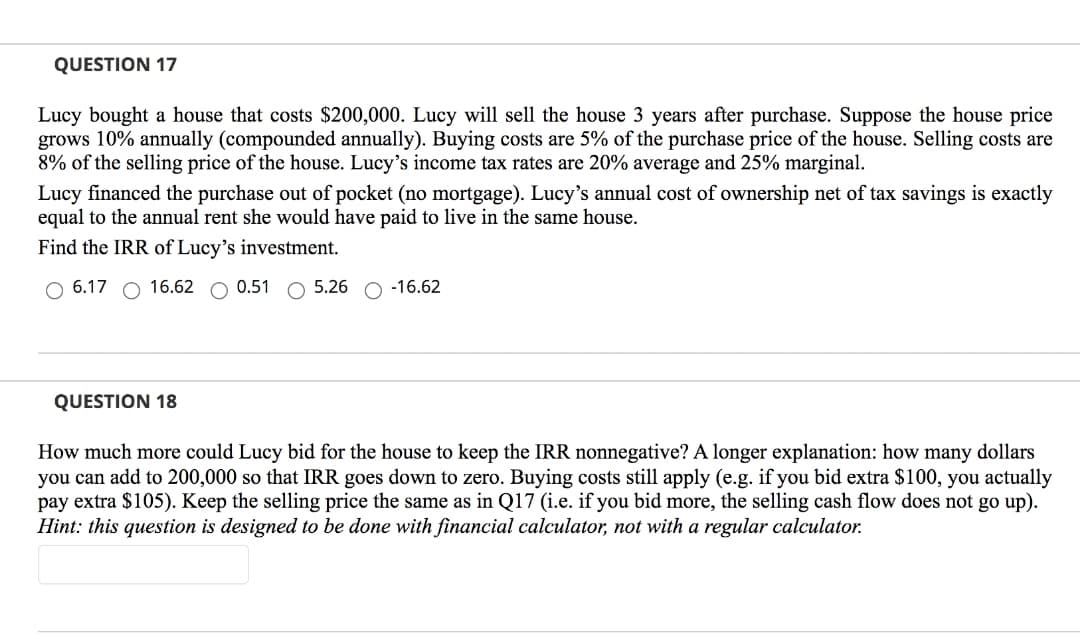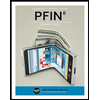QUESTION 17 Lucy bought a house that costs $200,000. Lucy will sell the house 3 years after purchase. Suppose the house price grows 10% annually (compounded annually). Buying costs are 5% of the purchase price of the house. Selling costs are 8% of the selling price of the house. Lucy's income tax rates are 20% average and 25% marginal. Lucy financed the purchase out of pocket (no mortgage). Lucy's annual cost of ownership net of tax savings is exactly equal to the annual rent she would have paid to live in the same house. Find the IRR of Lucy's investment. O 6.17 16.62 O 0.51 O 5.26 O -16.62
QUESTION 17 Lucy bought a house that costs $200,000. Lucy will sell the house 3 years after purchase. Suppose the house price grows 10% annually (compounded annually). Buying costs are 5% of the purchase price of the house. Selling costs are 8% of the selling price of the house. Lucy's income tax rates are 20% average and 25% marginal. Lucy financed the purchase out of pocket (no mortgage). Lucy's annual cost of ownership net of tax savings is exactly equal to the annual rent she would have paid to live in the same house. Find the IRR of Lucy's investment. O 6.17 16.62 O 0.51 O 5.26 O -16.62
Financial Accounting: The Impact on Decision Makers
10th Edition
ISBN:9781305654174
Author:Gary A. Porter, Curtis L. Norton
Publisher:Gary A. Porter, Curtis L. Norton
Chapter9: Current Liabilities, Contingencies, And The Time Value Of Money
Section: Chapter Questions
Problem 9.12AMCP
Related questions
Question

Transcribed Image Text:QUESTION 17
Lucy bought a house that costs $200,000. Lucy will sell the house 3 years after purchase. Suppose the house price
grows 10% annually (compounded annually). Buying costs are 5% of the purchase price of the house. Selling costs are
8% of the selling price of the house. Lucy's income tax rates are 20% average and 25% marginal.
Lucy financed the purchase out of pocket (no mortgage). Lucy's annual cost of ownership net of tax savings is exactly
equal to the annual rent she would have paid to live in the same house.
Find the IRR of Lucy's investment.
O 6.17
16.62 O 0.51 O 5.26 O -16.62
QUESTION 18
How much more could Lucy bid for the house to keep the IRR nonnegative? A longer explanation: how many dollars
you can add to 200,000 so that IRR goes down to zero. Buying costs still apply (e.g. if you bid extra $100, you actually
pay extra $105). Keep the selling price the same as in Q17 (i.e. if you bid more, the selling cash flow does not go up).
Hint: this question is designed to be done with financial calculator, not with a regular calculator.
Expert Solution
This question has been solved!
Explore an expertly crafted, step-by-step solution for a thorough understanding of key concepts.
This is a popular solution!
Trending now
This is a popular solution!
Step by step
Solved in 3 steps with 4 images

Knowledge Booster
Learn more about
Need a deep-dive on the concept behind this application? Look no further. Learn more about this topic, finance and related others by exploring similar questions and additional content below.Recommended textbooks for you

Financial Accounting: The Impact on Decision Make…
Accounting
ISBN:
9781305654174
Author:
Gary A. Porter, Curtis L. Norton
Publisher:
Cengage Learning

PFIN (with PFIN Online, 1 term (6 months) Printed…
Finance
ISBN:
9781337117005
Author:
Randall Billingsley, Lawrence J. Gitman, Michael D. Joehnk
Publisher:
Cengage Learning


Financial Accounting: The Impact on Decision Make…
Accounting
ISBN:
9781305654174
Author:
Gary A. Porter, Curtis L. Norton
Publisher:
Cengage Learning

PFIN (with PFIN Online, 1 term (6 months) Printed…
Finance
ISBN:
9781337117005
Author:
Randall Billingsley, Lawrence J. Gitman, Michael D. Joehnk
Publisher:
Cengage Learning
